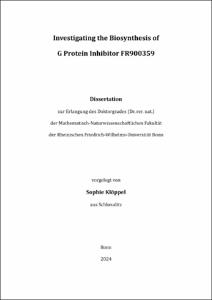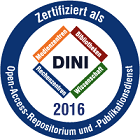Klöppel, Sophie: Investigating the Biosynthesis of G Protein Inhibitor FR900359. - Bonn, 2025. - Dissertation, Rheinische Friedrich-Wilhelms-Universität Bonn.
Online-Ausgabe in bonndoc: https://nbn-resolving.org/urn:nbn:de:hbz:5-80220
Online-Ausgabe in bonndoc: https://nbn-resolving.org/urn:nbn:de:hbz:5-80220
@phdthesis{handle:20.500.11811/12738,
urn: https://nbn-resolving.org/urn:nbn:de:hbz:5-80220,
author = {{Sophie Klöppel}},
title = {Investigating the Biosynthesis of G Protein Inhibitor FR900359},
school = {Rheinische Friedrich-Wilhelms-Universität Bonn},
year = 2025,
month = jan,
note = {FR900359 (FR) is a potent and selective inhibitor of Gq proteins, obstructing intracellular signaling of numerous G protein-coupled receptors (GPCRs). This makes it a promising pharmacological tool for investigating Gq-coupled signaling and potentially addressing diseases associated with aberrant Gq protein activation. FR is a cyclic depsipeptide composed of eight building blocks. Of particular importance are the side chain, N-propionyl-hydroxyleucine, and D-phenyllactate, which play crucial roles in FR’s inhibitory properties. FR is produced by an octamodular non-ribosomal peptide synthetase (NRPS) machinery encoded by the frs biosynthetic gene cluster (BGC), which was found to be harbored by the bacterial plant endosymbiont “Candidatus Burkholderia crenata” and the cultivable soil bacterium Chromobacterium vaccinii, facilitating the study of enzymes critically involved in FR biosynthesis catalyzing unique reactions.
FrsATE is a noncanonical thioesterase domain within the FR NRPS assembly line, catalyzing a rare intermolecular transesterification reaction between the side chain and FR-Core. To elucidate the reaction mechanism, experiments towards the comprehensive structural and functional characterization of FrsATE were conducted. Structural studies of FrsATE included bioinformatic analysis, protein construct optimization, and crystallization, resulting in the apo-structure of the FrsAT+TE didomain. Comparative analysis with homologous TE domains identified conserved structural features and substrate binding sites. 3D NMR experiments provided insights into protein dynamics during substrate interaction, laying a foundation for studying substrate recognition and catalysis. In vitro assays demonstrated flexibility in FrsA domain substrate specificity and confirmed the TE domain's acceptance of modified side chains, enabling the formation of novel FR analogs. These results provide profound insights into FrsATE’s potential for chemoenzymatic syntheses and structure-activity relationship investigations of cyclic peptide G protein inhibitors.
Biochemical studies of the nonheme diiron monooxygenase FrsH revealed its interaction with the FrsA adenylation domain. Mutagenesis and in vitro assays identified residues critical for domain recognition during leucine &#beta;-hydroxylation, suggesting potential for NRPS engineering. The NAD(P)H-dependent dehydrogenase FrsC was shown to catalyze the reduction of phenylpyruvate (PPA) to L-phenyllactate (PLA), with a preference for NADPH. In vivo, L-PLA is incorporated into the FR peptide chain and epimerized to D-PLA by FrsE3. These findings enhance understanding of FR biosynthesis and its potential for chemoenzymatic synthesis of G protein inhibitors.},
url = {https://hdl.handle.net/20.500.11811/12738}
}
urn: https://nbn-resolving.org/urn:nbn:de:hbz:5-80220,
author = {{Sophie Klöppel}},
title = {Investigating the Biosynthesis of G Protein Inhibitor FR900359},
school = {Rheinische Friedrich-Wilhelms-Universität Bonn},
year = 2025,
month = jan,
note = {FR900359 (FR) is a potent and selective inhibitor of Gq proteins, obstructing intracellular signaling of numerous G protein-coupled receptors (GPCRs). This makes it a promising pharmacological tool for investigating Gq-coupled signaling and potentially addressing diseases associated with aberrant Gq protein activation. FR is a cyclic depsipeptide composed of eight building blocks. Of particular importance are the side chain, N-propionyl-hydroxyleucine, and D-phenyllactate, which play crucial roles in FR’s inhibitory properties. FR is produced by an octamodular non-ribosomal peptide synthetase (NRPS) machinery encoded by the frs biosynthetic gene cluster (BGC), which was found to be harbored by the bacterial plant endosymbiont “Candidatus Burkholderia crenata” and the cultivable soil bacterium Chromobacterium vaccinii, facilitating the study of enzymes critically involved in FR biosynthesis catalyzing unique reactions.
FrsATE is a noncanonical thioesterase domain within the FR NRPS assembly line, catalyzing a rare intermolecular transesterification reaction between the side chain and FR-Core. To elucidate the reaction mechanism, experiments towards the comprehensive structural and functional characterization of FrsATE were conducted. Structural studies of FrsATE included bioinformatic analysis, protein construct optimization, and crystallization, resulting in the apo-structure of the FrsAT+TE didomain. Comparative analysis with homologous TE domains identified conserved structural features and substrate binding sites. 3D NMR experiments provided insights into protein dynamics during substrate interaction, laying a foundation for studying substrate recognition and catalysis. In vitro assays demonstrated flexibility in FrsA domain substrate specificity and confirmed the TE domain's acceptance of modified side chains, enabling the formation of novel FR analogs. These results provide profound insights into FrsATE’s potential for chemoenzymatic syntheses and structure-activity relationship investigations of cyclic peptide G protein inhibitors.
Biochemical studies of the nonheme diiron monooxygenase FrsH revealed its interaction with the FrsA adenylation domain. Mutagenesis and in vitro assays identified residues critical for domain recognition during leucine &#beta;-hydroxylation, suggesting potential for NRPS engineering. The NAD(P)H-dependent dehydrogenase FrsC was shown to catalyze the reduction of phenylpyruvate (PPA) to L-phenyllactate (PLA), with a preference for NADPH. In vivo, L-PLA is incorporated into the FR peptide chain and epimerized to D-PLA by FrsE3. These findings enhance understanding of FR biosynthesis and its potential for chemoenzymatic synthesis of G protein inhibitors.},
url = {https://hdl.handle.net/20.500.11811/12738}
}






